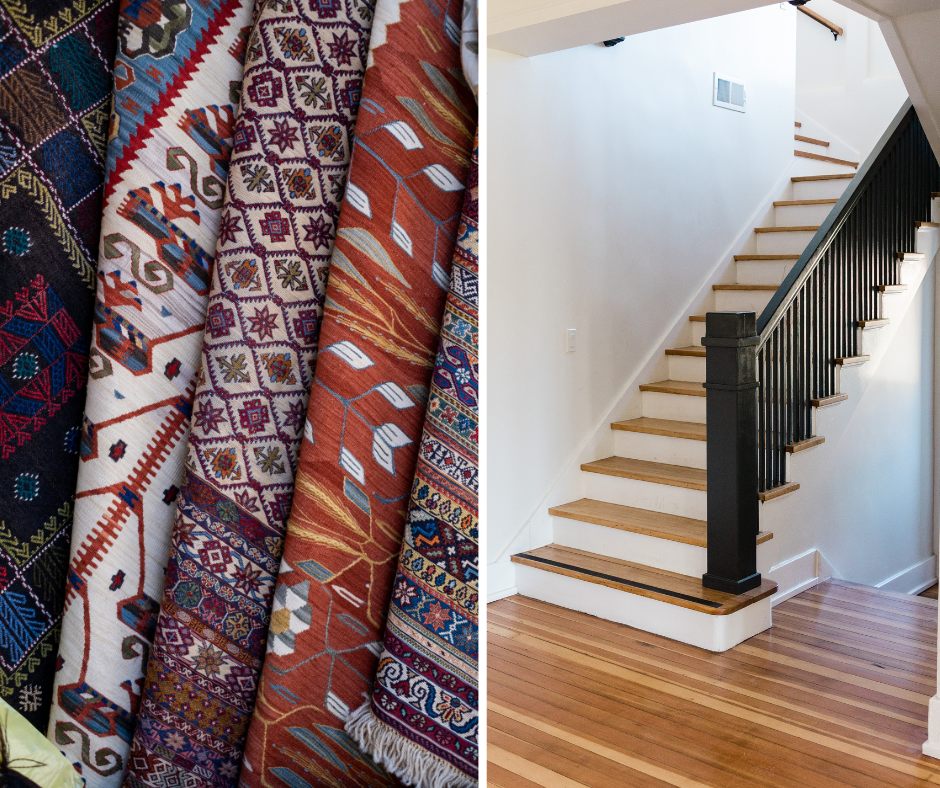When updating your staircase, knowing the most used stair treads shapes and sizes can help you create a safe and stylish look with a unique touch.
From classic bullnose shapes to practical retrofit options, understanding the right shape and size can make every step feel comfortable.
Adding a cozy carpet stair landing can enhance comfort, making the staircase a welcoming and luxurious part of your home.
What Are the Common Shapes for Stair Treads?
Knowing the shapes of stair treads can help you match the staircase’s look to the style of your home.
Here’s a look at the most commonly used shapes:
1. Standard Bullnose Treads
Standard bullnose treads feature a smooth, rounded front edge, giving them a classic look that’s soft underfoot.
This shape works well in most home styles, making it one of the most popular choices for residential staircases.
2. Mitered Return Treads
Mitered return treads offer a polished finish on open staircases, giving a neat edge that enhances a modern look.
This shape wraps around the edges and is perfect for homeowners wanting a smooth, updated appearance.
3. Landing Treads (Bullnosed Landing Tread)
Landing treads work well on stairs with turns or level changes.
Their bullnose shape on one side adds a finished look to these sections and creates a secure, stylish landing space.
4. Retrofit Treads
For a convenient remodel option, retrofit treads install easily over existing stairs, making them a simple way to refresh an outdated staircase without major renovations.
Why Sizes of Stair Treads Matter
Selecting the right size for stair treads is essential to both safety and style.
Common sizes range from 9 to 11 inches deep, providing enough space for secure steps without feeling cramped.
For a luxurious look, many homeowners prefer wider treads around 11 inches.
This additional space not only adds comfort but also highlights the staircase as an attractive feature in the home.
If you’re considering carpet stair treads, matching the size to the tread helps with both appearance and safety, especially on high-traffic stairs.
Residential Stair Treads Shapes and Sizes: What to Consider
Finding the ideal stair tread for a home involves balancing comfort, safety, and aesthetics.
Here’s a breakdown of standard sizes often used in residential staircases:
- Depth: Ranges from 9 to 11 inches, providing ample space for a stable step.
- Width: Most residential treads are about 36 inches wide, though larger stairs may use up to 42 inches.
- Thickness: Typically ¾ inch to 1 inch, depending on the material and style.
These measurements are popular for residential staircases because they suit a variety of architectural styles and can be easily customized to meet specific needs.
What Materials Are Commonly Used for Stair Treads?
The material used for stair treads affects durability and appearance.
Here are the most common options:
1. Wood
Wood remains a top choice for its natural beauty and lasting appeal.
Popular options include oak, maple, and walnut, each offering unique colors and textures that suit both classic and contemporary homes.
2. Carpeted Treads
Carpet stair treads add warmth, reduce slip, and can be tailored to fit various shapes and sizes.
They’re a cozy choice for homes with children or pets, adding softness underfoot and reducing noise.
3. Laminate and Vinyl
Laminate and vinyl stair treads are durable, budget-friendly, and easy to maintain.
They come in a wide range of colors, including wood-look finishes, making them versatile for any staircase.
Steps to Success
When choosing stair treads, focus on the shape, size, and material that best fits your home and lifestyle.
Consider the safety, comfort, and style that each option offers, and keep in mind how they’ll look and feel over time.
With so many options—from timeless wood to cozy carpeted treads—finding the right fit can transform your staircase into a beautiful feature that enhances your home.




